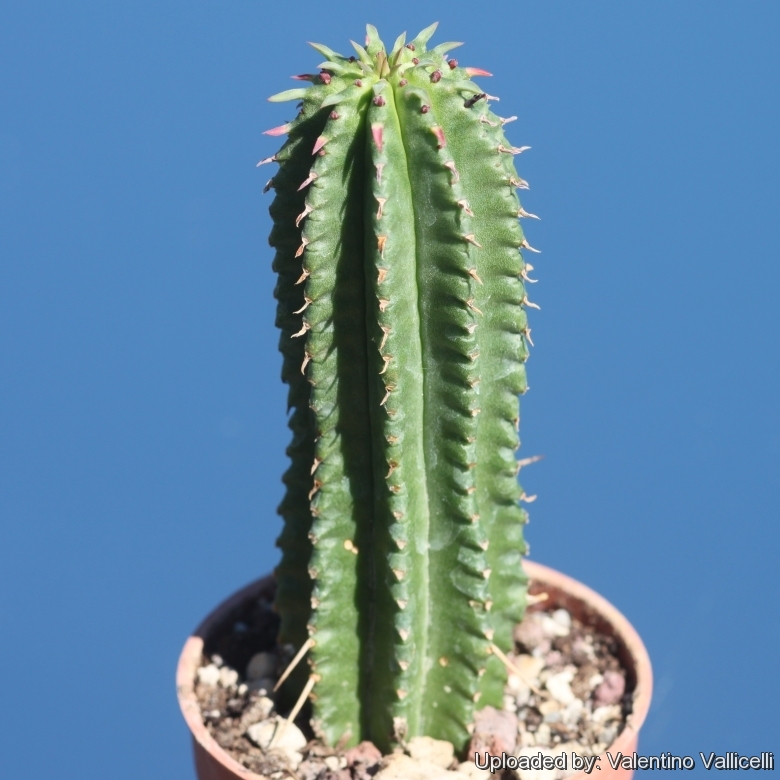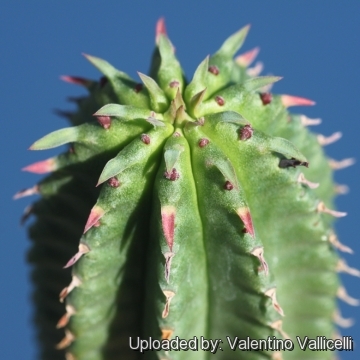
Euphorbia fimbriata Photo by: Valentino Vallicelli
Origin and Habitat: Western Cape, Republic of South Africa.
Synonyms:
See all synonyms of Euphorbia fimbriata
back
Accepted name in llifle Database:Euphorbia fimbriata Scop.Delic. Fl. Faun. Insubr. 3: 8. 1788 [Jan-Sep 1788]Synonymy: 7
back
Common Names include:
RUSSIAN (Русский): Молочай фимбриата
Description: Euphorbia fimbriata is a dioecious succulent shrublets up to 30 cm tall (but up to 1 m hight in shade) simple, or frequently suckering from the base and branching irregularly
Branches: 1,5 - 4 cm in diameter, erect to decumbent, simple or branching above, deep green, becoming reddish or brownish in sun.
Ribs: 7 to 15, rather compressed, more or less deeply grooved between, with somewhat raised and lumpy conical tubercles each with a white leaf scar, separated by horizontal grooves up to 4 mm apart.
Leaves: Rudimental, linear, acute, up to 3 mm long, rapidly deciduous.
Spines: The so called “spines” are solitary sterile peduncles up to 14 mm long usually maroon-tipped.
Inflorescences: Cyathia solitary in groups near branches tips, peduncles to 5 mm long with several small bracts. Male Cyathia up to 6 mm in diameter. Female up to 4 mm in diameter, nectar glands touching. Variable from green-yellow to purple or maroon.
Blooming season: The Euphorbia fimbriata blooms in winter.
Fruits: Subsessile.
Remarks: The related Euphorbia mammillarias has more hexagonal tubercles and starts branching above on the stem.
Bibliography: Major references and further lectures
1) Urs Eggli “Illustrated Handbook of Succulent Plants: Dicotyledons” Volume 2. Springer, 2002
2) Walther Haage “Cacti and succulents: a practical handbook” Dutton, 1963
 Euphorbia fimbriata Photo by: Valentino Vallicelli
Euphorbia fimbriata Photo by: Valentino VallicelliSend a photo of this plant.The gallery now contains thousands of pictures, however it is possible to do even more. We are, of course, seeking photos of species not yet shown in the gallery but not only that, we are also looking for better pictures than those already present.
Read More... Cultivation and Propagation: Euphorbia fimbriatais an easy to grow ornamental species suited for any well drained soil in half or full sun.
Growth rate: It is a relatively fast growing species, but it it possible to increase the speed of growth to some extent by providing adequate amount of water, warmth, and fertilizer during the active growing season, but it’s susceptible to rotting if too wet and do not like a lot of water when it is on rest.
Soil and pots: It likes pots with generous drain holes, needs a very airy potting medium which mainly consists of non organic material such us clay, pumice, lava grit, and only a little peat or leaf-mould,
Fertilization: Need a perfect fertilizer diet in summer. Use preferably a cacti and succulents fertilizer with high potassium content including all micro nutrients and trace elements or slow release fertilizer.
Exposure: This plant has an excellent heat tolerance, and need light shade exposures, it grows well even in full blasting sun, but tolerate moderate shade, and a plant that has been growing in shade should be slowly hardened off before placing it in full sun as the plant will be severely scorched if moved too suddenly from shade into sun. The colour of this plant is much more marked if grown in full sun.
Watering: Euphorbia fimbriatais an opportunistic grower, water regularly when it is growing. No water should ever be allowed to stand around the roots. Keep almost completely dry in winter. However this spurge will tolerate dryness and can even thrives in poor, dry soils, but do better when grown in nutrient-rich soils with regular watering.
Hardiness: Tender. This spurge cannot tolerate any frost and can be difficult to get it to look its best without a good amount of heat and sun and so it is only really suited to the tropics. It can be grown outdoors in frost-free climates.
Rot: Rot it is only a minor problem with Euphorbias if the plants are watered and “aired” correctly. If they are not, fungicides won't help all that much.
Maintenance: Re-pot every two years and trim off the dead 'arms'.
Known hazards: The latex/sap is poisonous and can cause skin rash, itching and general discomfort, and they should be handled with caution, particularly when pruning.
Propagation: The plant can be reproduced by seeds or cuttings. The plant may be propagated by branch cuttings. If you remove an offset, remember to let it dry for some days, letting the wound heal (cuttings planted too soon easily rot before they can grow roots). Lay it on the soil and insert the stem end partially into the substrate. Try to keep the cutting somewhat upright so that the roots are able to grow downward. It is better to wash the cut to remove the latex.











